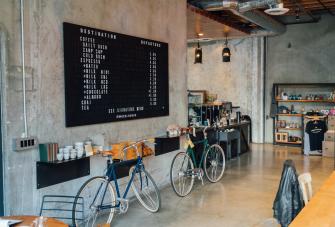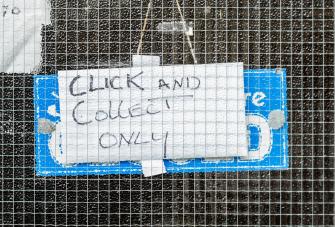What Is a Product Assortment Strategy?
We’re about to be heading into the busiest time of the year for retailers. Black Friday. Cyber Monday. Christmas. The orders are going to be flooding in.
The only problem is, you have no clue what products to put on your shelves.
You’ve got limited storage, limited space, and every single item sitting in your warehouse needs to be gone by the end of the year so that you can make a healthy profit.
This is where retail assortment planning comes in.
Now, don’t let the term scare you. It’s not complicated. It just means choosing the right products, at the right time, in the right place. Planning ahead instead of guessing.
Because when you do that, you’re not left with piles of store inventory you can’t shift. You don’t waste space. You give customers exactly what they came looking for.
So today we'll run through everything there is to know about assortment planning in retail. From why it's important and the different types to how to make an assortment plan that works. We’ll give you simple tips, real examples, and strategies you can start using right away.
Why product assortment strategy matters for retail success
Assortment planning is super important when it comes to your inventory management because it helps you:
Increase sales and satisfy customer demand
Well‑designed assortment influences purchase decisions, reduces dead stock, and builds trust.
When people walk into your store, they expect to find what they came for, like umbrellas in the rainy season or diaries in January.
Now, when you consistently meet those needs, customers trust you more, shop more often, and leave happier. Customer trust is huge. In fact, a staggering 93% of business executives agree that building and maintaining trust improves the bottom line.
If you can't meet those needs, however, because you don't have the right product mix or because you've run out of your most popular items, customers are going to leave empty-handed and walk right into the arms of your competitors.
This'll cost you. In fact, according to recent research, stockouts cost retailers an estimated $350 billion every year, so making sure the right products are always available pays off big time.
Adapt to market trends and seasonality
Retail isn’t steady. It moves in waves. One month it’s back-to-school, the next it’s Christmas. Then it’s summer, and suddenly everyone wants sunglasses and dresses.
If your store doesn’t adapt to customer demand, you miss out because customers don’t wait around; they’ll just buy from someone else.
That’s why assortment planning matters. It keeps your shelves relevant. It makes sure the products you’re offering match what people actually want, right when they want it.
The best retailers don’t just follow the seasons. They move with trends, too. Take Zara, for example. Their fast-fashion model is built on quick adaptation. New styles hit the shelves almost weekly. They’re constantly refreshing assortments so customers always see something new, and that keeps people coming back.
However, do this responsibly. Fast fashion, as we all know, has a huge environmental cost. So while adapting quickly is smart, it’s even smarter to do it in a way that’s sustainable. Maybe you stock a timeless product mix that would work well for a capsule wardrobe and last beyond just a single season.
Efficient inventory management
Inventory can be make or break for retailers. Too much of the wrong product, and you’re drowning in stock you can’t sell. Too little of the right product, and you’re losing sales.
With smart assortment planning, you can use past sales history from your POS system to guide those choices. Looking at what worked before, spotting the patterns, and making smart decisions to help maximize sales.
For instance, say you work at a big box store - a bit like IKEA. You’ve got the space to go wide. You can stock sofas, chairs, tables, lamps (every category under the sun) because customers expect that level of variety. In this case, you could use your retail POS system to:
- Track which product categories are your top performers and expand.
- Identify slow-moving stock and reduce future orders to avoid waste. Plus, you can even put these orders into seasonal sales or bundle a particular product with another to make sure you're clearing what you have.
- Spot seasonal trends and plan stock accordingly.
- Compare performance across locations to tailor assortments to local demand.
- Balance wide variety with smart inventory levels so shelves look full but stockrooms aren’t overflowing.
The point is, you’re not guessing. You’re making inventory decisions backed by data. That’s how you keep inventory lean, relevant, and profitable.
Types of retail assortment strategies
Let’s talk about the different ways stores can stock their products. There are a few main types, and each one works for different kinds of retailers:
Wide (Broad) assortment
This is when a store carries lots of different types of products but not too many options within each type. Think assortment retailers like Target or Walmart. They’ve got a little bit of everything to appeal to lots of people.
Deep assortment
Here, a store focuses on fewer categories but offers tons of variations. Shoe stores or specialty shops, like Nordstrom, do this. Lots of styles, sizes, and colors in a single category. A deep assortment strategy would be needed in this case.
Scrambled assortment
Some stores mix things up and sell items outside their main products. This attracts different types of shoppers and encourages impulse buys. Imagine a grocery store that also sells kitchen gadgets or a bookstore with gifts and snacks.
Localized assortment
This is all about customizing stock for where your store is. Jackets in cold areas, swimwear in warm areas. It makes sure customers can find what they actually need where they live. You could also anticipate in-season trends. If you're based in Aspen, for example, you'll definitely want skis, snow boots, and cozy jackets before après season.
Knowing which assortment type you fall into is super important, so make sure you have a think about the assortment planning process and assortment planning models you fall into.
Assortment planning process: Step-by-Step
You know what assortment planning is and why it's great - yay! It's time to get practical. Here's how retailers create the perfect assortment planning process:
Step 1: Define strategy (Core, seasonal, trends)
Think of your assortment strategy as your game plan for what you’ll stock in your store.
You need to decide:
- What types of products to carry
- How many sizes
- Colors
- Which brands to offer
- How much budget and shelf space each product gets
This is also known as your merchandising assortment plan.
Now, you can split your inventory into three main buckets:
- Core: The reliable sellers that move all year, like your everyday basics.
- Seasonal: Stuff people only want at certain times, like sunscreen in summer or scarves in winter.
- Trend: The “hot right now” products that aren’t tied to a season. If you're reading this in 2025, for instance, Labubu toys are all the rage at the moment.
Unfortunately, there isn't an exact formula for how much goes into each bucket. It’s all about testing and seeing what clicks for your store.
Remember, these percentages can change throughout the year, too. Maybe normally it’s 50% core, 20% seasonal, 30% trend. But come Black Friday and Cyber Monday, you might flip the trend and seasonal stock to make the most of the shopping rush.
Step 2: Build category structure & product mix
Assortment planning is really great for optimizing inventory. It does this by looking at the most profitable and popular product mix and getting rid of all the under-performing items.
You can achieve this with SKU rationalization. Here's how:
Go through your stock and sort each item into core, seasonal, or trend. Do it by SKU, not just product type. For example, dark jeans might fly off the shelves in winter, while white jeans are summer bestsellers, even though they’re both “jeans.”
Step 3: Use data, sales history + customer demand + market trends
Once your categories and product lines are set, it’s time to back it up with data. You’ve got two options here. You could guess … or use your sales history, customer behavior, and market trends to make decisions that actually work. Epos Now's POS software is great for this.
Look at past sales and sales volume, see what people bought and when. Spot trends, check what’s hot right now, and balance your stock so you’re never overstuffed with slow-movers or running out of the stuff everyone wants. Data really can be your cheat sheet to smarter assortment planning.
Step 4: Set sales targets & inventory levels
Sales targets (also known as retail KPIs) tell you how much money you can realistically make from each product category.
Knowing this helps you set a smart open-to-buy budget so you’re not spending more on stock than you’re likely to sell. Plus, it keeps your cash flow healthy.
Here’s how to set them:
- Check your sales data: See what sold last year around the same time. Which products flew off the shelves? Which ones sat there collecting dust?
- Do a quick market check: Any seasonal trends or hot items coming up that could boost sales for a certain category?
- Look at your supply chain: Are there any sourcing issues that might limit how much stock you can actually get?
Basically, it’s about being smart. Set targets based on what the numbers are actually telling you, and you’ll be way less likely to overstock, or miss out on sales.
Step 5: Build a planogram
A planogram is essentially a blueprint for your shelves. It shows exactly where each product should go in your store so customers can actually find what they want. This is super handy for seasonal or trending items. Think eye-level spots or end caps where people are most likely to notice them.
Planograms also help you figure out space. How much room does each product get? That tells you exactly how much stock you need to keep the shelves full without overdoing it.
The same idea works online, too. Your website has “prime real estate” too - homepage banners, image carousels, featured sections.
Put your seasonal hits or best-sellers there so they get the attention they deserve.
Step 6: Create your inventory management plan
By now, you know what products you’re stocking, how much is core, seasonal, or trending, and where everything goes on the shelves.
Now, let’s cover the last two things:
- Safety stock: Think of this as your store’s emergency fund. It’s the minimum amount of product you keep on hand so you don’t run out when demand spikes. That way, you can still serve customers while you restock.
- Stock replenishment: Don’t stress about manually tracking everything. Tools like Stocky can automatically reorder products when they drop below your safety stock, keeping your shelves full without any guesswork.
Once you've completed all these steps, it's time to monitor and adjust until you've nailed your product mix and are able to manage inventory like a pro and attract customers from all over.
Best practices to optimize product assortment strategy
We've explained the process but we thought we'd also add some extra tips to really help you nail it:
Blend staples with loss leaders
Keep your must-have products on shelves, but throw in some loss leaders to bring people in and boost basket size. You can do this via upselling bundles, or cross-promoting. People come for the deal, stay for the rest.
Factor in seasonality and trends
Change your stock for holidays, special events, or what’s popular right now. Be ready to swap products so you don’t get stuck with things nobody wants.
Leverage customer data insights
Look at what people buy together, what new customers usually buy first, and how people shop online vs. in-store. This tells you what products to stock and where, and how to use loyalty programs to encourage repeat purchases.
Tailor by store format & geography
Big stores can carry lots of items, small stores need to be more focused. Also, think about location - cold areas need jackets, hot areas need swimwear. Stock what your customers actually need.
Use assortment planning tools & analytics
Tools and software can help you see what sells best, what’s trending, and how much to stock.
Challenges and how to overcome them
Even with the best plan, there are some tricky bits when it comes to assortment planning. Here’s what to watch out for:
Space, capital, and operational constraints
Stocking lots of different products takes space and cash. Smaller or specialty stores can’t do it all, so pick the items that matter most and focus on them.
Risk of overstock or stockouts
If you guess wrong, you might have too much of something (and have to mark it down) or run out of popular items (and lose sales). Using data and keeping an eye on trends helps avoid both problems.
Maintaining relevance in dynamic markets
Markets and customer tastes change fast. Your assortment plan can’t be set in stone. Keep updating it with sales data, customer feedback, and supply changes so your store always has what people want.
TIP: We have a complete guide on all the problems and solutions you’ll come across in retail. Check it out for more information.
Final thoughts
That's it from us. You've officially got all the insider intel you need as retailers to succeed in retail assortment planning.
Ready to make it even easier? Epos Now’s retail POS helps you manage inventory, track sales, and plan assortments all in one place. Get smarter, faster, and keep your shelves stocked with what your customers really want.
- What is a product assortment strategy in retail?
-
It’s how you pick and mix products to keep customers happy and increase sales.
- What is localized assortment and why does it matter for retailers?
-
It’s stocking stuff that fits the local vibe, so you’re actually selling what people want.
- What are the biggest challenges in managing a product assortment strategy?
-
Balancing space, money, and trends without running out or overstocking.




